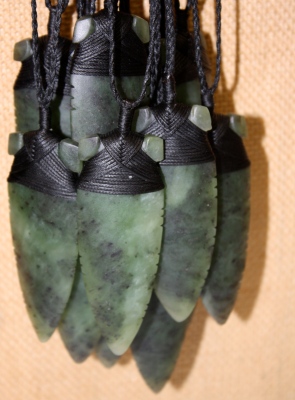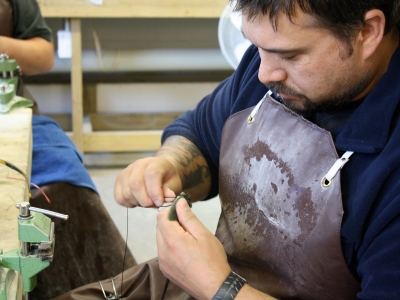NZ greenstone treasures for golden rowers

Rowing champions will take more than memories home from the 2010 World Rowing Championships in New Zealand - each gold medallist will receive a treasured pounamu taonga / treasure as a gift from local Māori.
The greenstone pendant, hand-carved in a paddle shape, will be placed around the neck of every gold-winning crew member at the same time they receive their traditional FISA World Championship medal.
It is believed to be the first time such a gesture has been made at a major sporting event in New Zealand.
Gift from iwi
The special gift is from the region’s local iwi or Māori tribe who say they want to acknowledge the achievement of the athletes, and send them home with a better understanding of the New Zealand culture as well as a special memory of their visit.
Respected Māori artist and specialist pounamu carver Lewis Gardiner, of Rotorua, was commissioned to make 150 taonga and says it has taken about three months to complete the task.
The pounamu - otherwise known as New Zealand greenstone or nephrite jade - comes from Big Bay in South Westland, on the West Coast of the South Island.
Hoe or paddle
Gardiner says the taonga are carved into a simplified form of a hoe or Māori paddle. Each has three notches down the side which references the local iwi and their guardianship or kaitiaki of the Waikato River taniwha / water spirit.
The Niho Taniwha or dragon’s tooth shape is identified as a pattern of Te Arawa and Waikato iwi.
The binding on top of each pendant acknowledges the hard work the recipients have put into gaining their achievements.
"When the athletes are gifted these taonga I hope they take away a big part of New Zealand Māori culture - something that when they go home they can recall their time in New Zealand and have fine memories of it," says Gardiner.
Valuable material
Gardiner says he would like people to have an understanding of how important pounamu is to Māori culture and to New Zealand as a whole.
"Pounamu has been very, very important over long period of time - it’s a most valuable material and cherished amongst Māori society. The material itself is now harder to obtain and being more rare puts more mana or wealth in it.
"Most Kiwis associate pounamu or greenstone with New Zealand - it’s part of the kiwiana culture with New Zealanders in general," says Gardiner.
Being involved in the World Rowing Championships and being asked by iwi to produce the taonga was a great honour, he said.
"I personally hope that the athletes appreciate the effort that particularly iwi have put in to gift them a pounamu taonga. In Māori terms it is one of the most prestigious gifts someone can give someone else."
Background: Lewis Gardiner - Māori carver
Lewis Tamihana Gardiner represents Te Arawa, Ngāti Awa, Whanau a Apanui, Ngāi Tahu Māori iwi / tribes.
He was born and raised in Mataura, Southland, but returned to his family land at Rotoiti near Rotorua in 1989.
Gardiner is regarded as one of the most innovative and respected Māori jade artists of his generation.
In 1994, he graduated in Māori Craft and Design from the Waiariki Institute of Technology in Rotorua. During his final year he was introduced to the valuable medium of pounamu jade.
Māori have always valued pounamu for both its hardness and translucent beauty, and Lewis was immediately attracted to its artistic possibilities.
"Our tupuna (ancestors) have given us, the Māori people, the resource and knowledge base to provide a reference for us and our children for years to come," says Gardiner.
In 1995, he became a full-time jade and bone carver specialising in traditional Māori imagery. Since then he has established his own business and developed a distinctive style.
Winning the bi-annual Mana Pounamu Awards for contemporary Māori design in 1999, 2001, and 2003, further enhanced Gardiner’s reputation.
In 2003, he travelled to China to visit a master jade carver to source tools and study techniques to carve on a larger scale.
His unique sense of design and use of inlay, coupled with his ability to envision large-scale works — often using several varieties of jade — has set Gardiner apart and his work is now valued by collectors in New Zealand and throughout the world.

